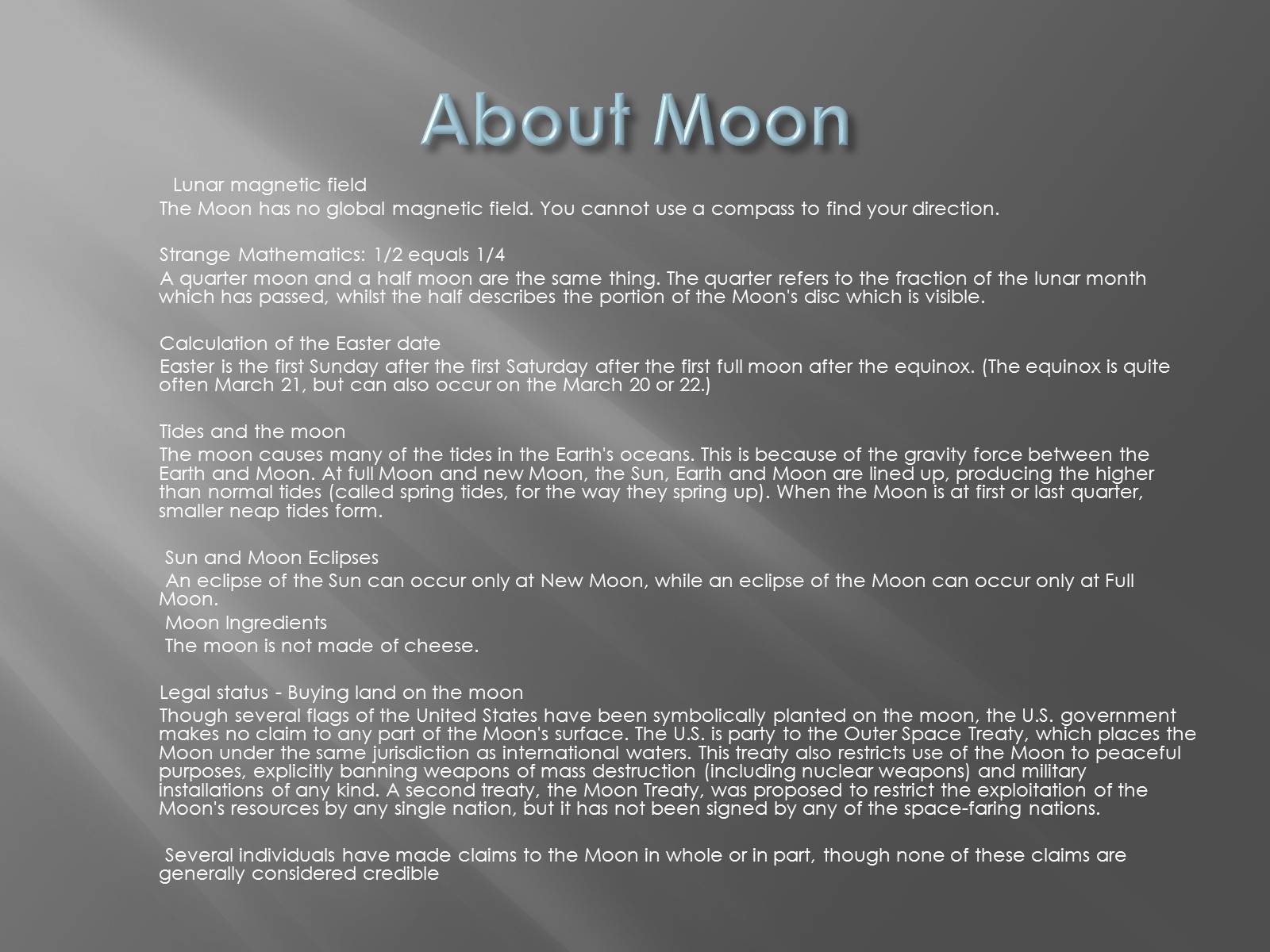- Головна
- Готові шкільні презентації
- Презентація на тему «Moon»
Презентація на тему «Moon»
354
Слайд #1
Moon
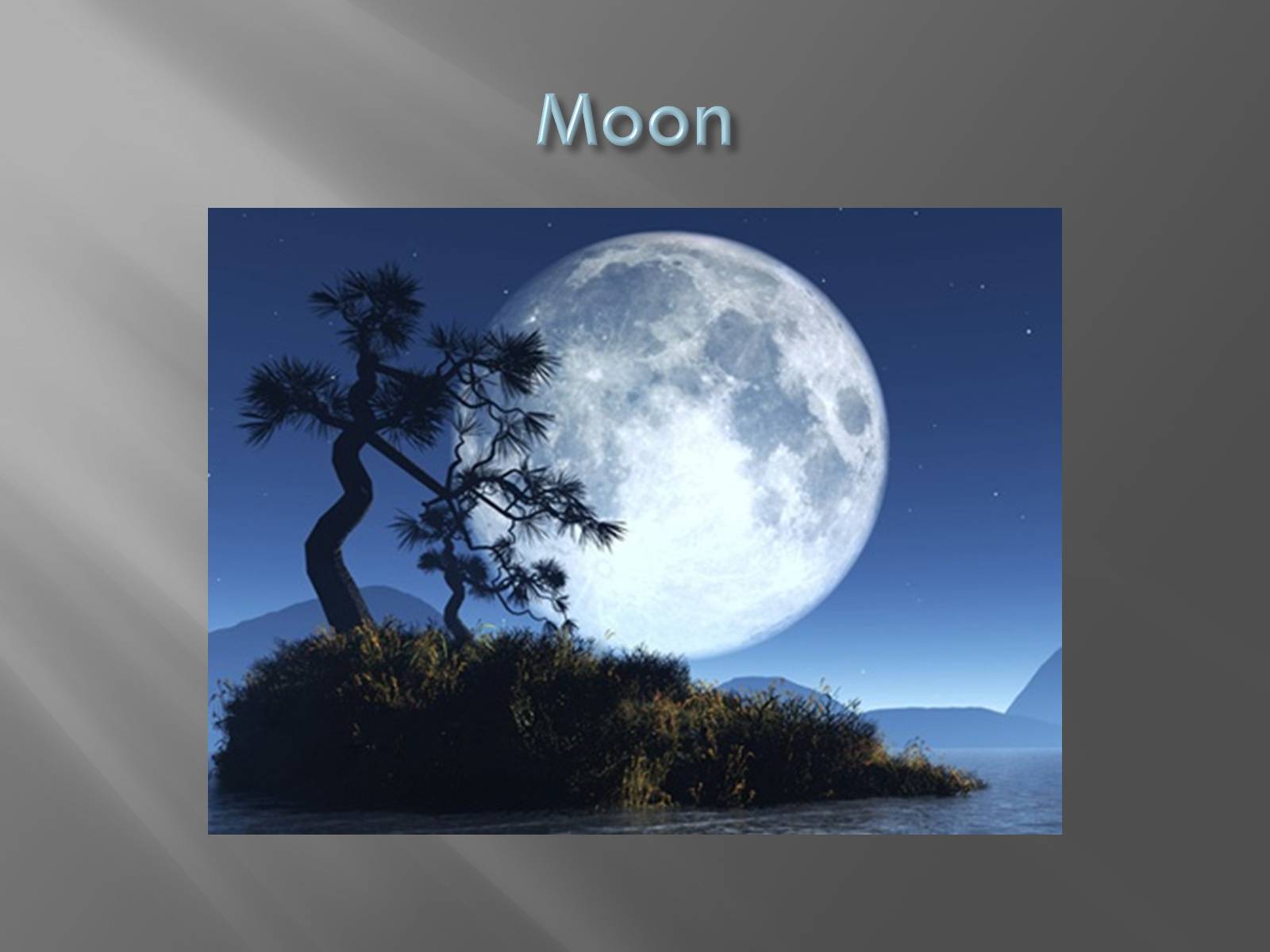
Слайд #2
About Moon
Name:tMoon
Age:t4.5 billion years old
Mass:t73'490'000'000'000'000 million kg
Shape:tEgg-shaped
Family:tMember of our solar system, satellite of earth
Active Relationships: tOrbits around the earth
Distance from earth: t384'467 km (~364 397 km at perigee,
~406 731 km at apogee)
Traveling by car: t130 days
Traveling by rocket: t13 hours
Traveling by light speed: t1.52 sec
Diametert3476 km (1/4 of the Earth's)
Driving around by car:t4 days
Gravity acceleration:t1.62m/sec2 (1/6 of Earth's)
Revolution period:t27.3217 days
Mean Synodic period
(new moon to new moon):t29.530588861 days
Mean orbital velocity:t1.023 km/sec
Name:tMoon
Age:t4.5 billion years old
Mass:t73'490'000'000'000'000 million kg
Shape:tEgg-shaped
Family:tMember of our solar system, satellite of earth
Active Relationships: tOrbits around the earth
Distance from earth: t384'467 km (~364 397 km at perigee,
~406 731 km at apogee)
Traveling by car: t130 days
Traveling by rocket: t13 hours
Traveling by light speed: t1.52 sec
Diametert3476 km (1/4 of the Earth's)
Driving around by car:t4 days
Gravity acceleration:t1.62m/sec2 (1/6 of Earth's)
Revolution period:t27.3217 days
Mean Synodic period
(new moon to new moon):t29.530588861 days
Mean orbital velocity:t1.023 km/sec
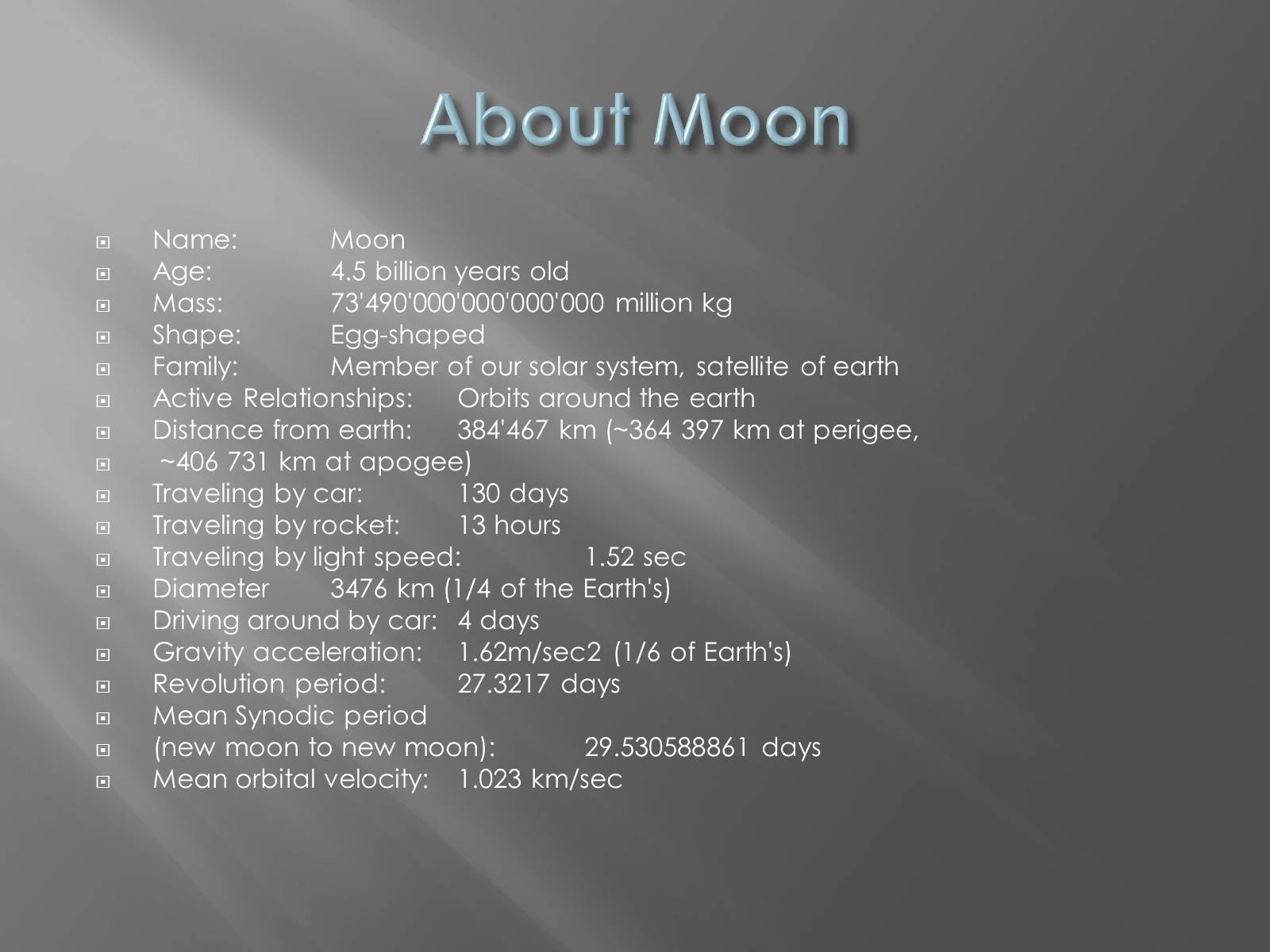
Слайд #3
About Moon
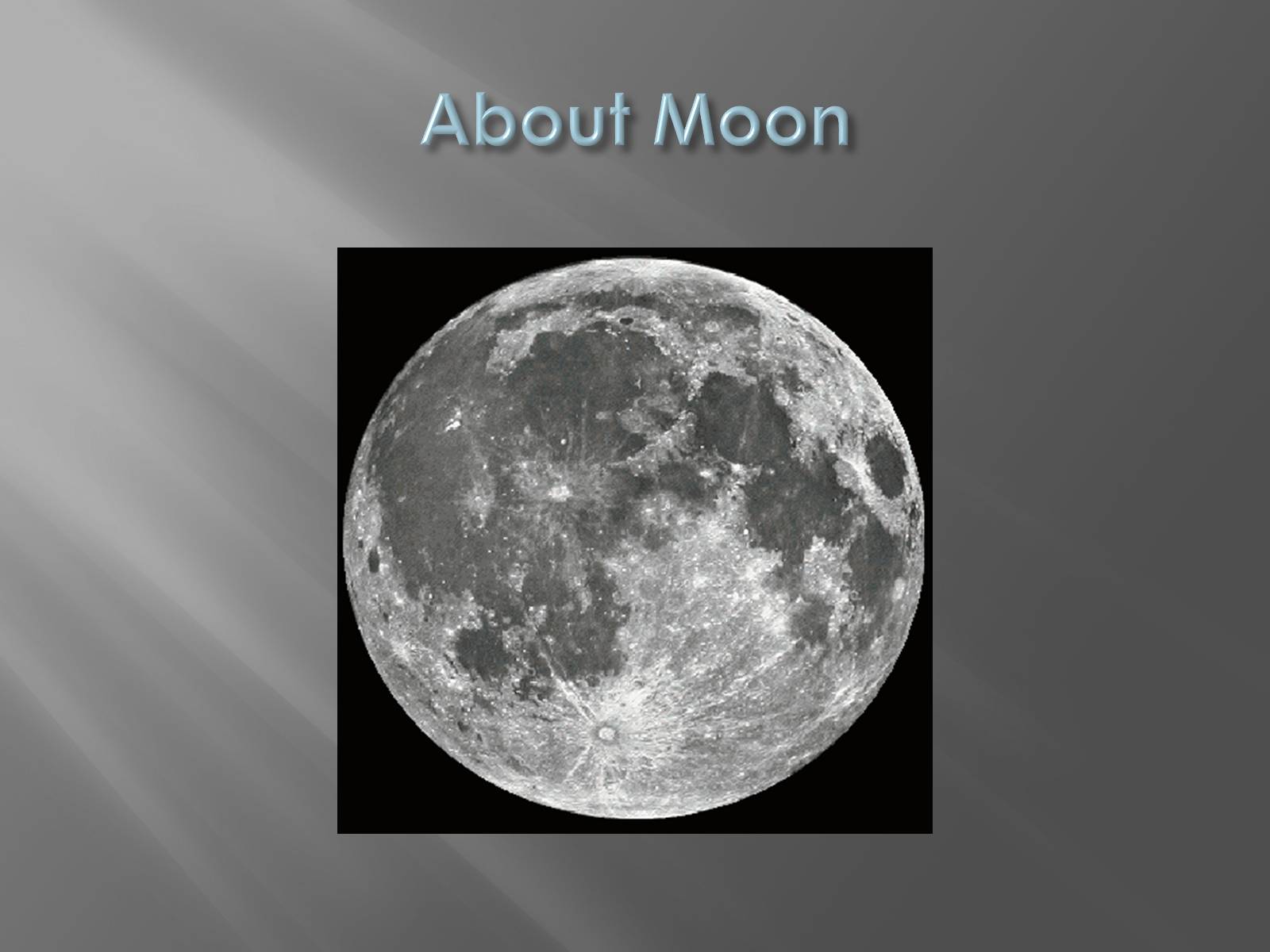
Слайд #4
About Moon
Rotation of moon
The same side of the Moon always faces the Earth. The Moon's rotation period is synchronous with its revolution period around the Earth.
Change of distance
Because of a loss of orbital energy to gravity from the Earth, the Moon is very gradually moving away from the Earth. In the very early history of the Earth, the Moon looked about 3 times larger in apparent size in the sky, because it was closer to the Earth.
Lunar atmosphere
The Moon has almost no atmosphere, because of its weak gravity. All types of gas will escape from its surface.
Without an atmosphere, there is no wind or water erosion. The Moon's surface is about the same now as it was 3 billion years ago. The astronauts' footprints remain unchanged on the Moon's surface. The footprints should last at least 10 million years.
Temperatures on the moon, dress code
The surface temperature fluctuates from roughly +300° F during the 2-week daytime to -270 F during the 2-week night. This is because there is not enough atmosphere to keep the Moon warm at night, nor protect it from the Sun's rays in the daytime. If you are wondering what to wear, an astronaut's suit is the most appropriate answer.
Rotation of moon
The same side of the Moon always faces the Earth. The Moon's rotation period is synchronous with its revolution period around the Earth.
Change of distance
Because of a loss of orbital energy to gravity from the Earth, the Moon is very gradually moving away from the Earth. In the very early history of the Earth, the Moon looked about 3 times larger in apparent size in the sky, because it was closer to the Earth.
Lunar atmosphere
The Moon has almost no atmosphere, because of its weak gravity. All types of gas will escape from its surface.
Without an atmosphere, there is no wind or water erosion. The Moon's surface is about the same now as it was 3 billion years ago. The astronauts' footprints remain unchanged on the Moon's surface. The footprints should last at least 10 million years.
Temperatures on the moon, dress code
The surface temperature fluctuates from roughly +300° F during the 2-week daytime to -270 F during the 2-week night. This is because there is not enough atmosphere to keep the Moon warm at night, nor protect it from the Sun's rays in the daytime. If you are wondering what to wear, an astronaut's suit is the most appropriate answer.
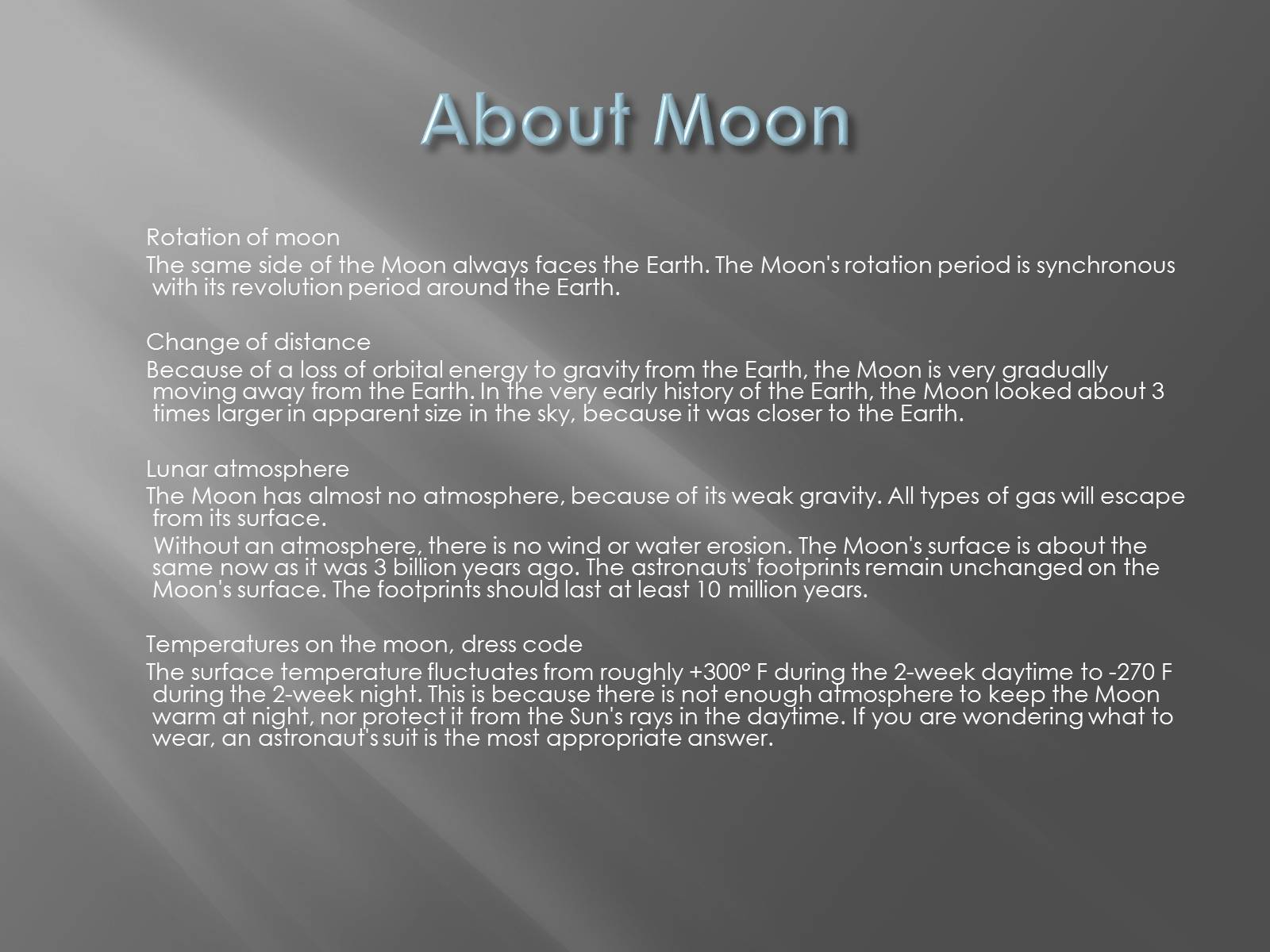
Слайд #5
About Moon
The Apollo 11 mission to the moon
The Apollo 11 Saturn V space vehicle, at Launch Pad 39A, awaits the liftoff scheduled for 9:32 a.m. EDT, along with astronauts Neil A. Armstrong, Michael Collins and Edwin E. Aldrin Jr.
During the planned eight-day mission, Armstrong and Aldrin descended in a lunar module to the Moon's surface while Collins was orbiting overhead in the command module. The two astronauts spent 22 hours on the Moon, including two and one-half hours outside the lunar module. They gathered samples of lunar material and deployed scientific experiments.
They rejoined Collins at the command module for the return trip to Earth.
The astronauts splashed down in the Pacific Ocean and recovery was made by the U.S.S. Hornet on July 24, 1969.
Just twenty seconds' worth of fuel remained when Apollo 11's lunar module landed on the moon.
The multi-layered space suit worn by astronauts on the Apollo moon landings weighed 180 pounds on Earth and 30 pounds on the Moon with the reduced lunar gravity.
The average desktop computer contains 5-10 times more computing power than was used to land a man on the moon.
The surface speed record on the Moon is 10.56 miles per hour. It was set in an Apollo lunar rover.
Size comparison
The volume of the Earth's moon is the same as the volume of the Pacific Ocean.
The Apollo 11 mission to the moon
The Apollo 11 Saturn V space vehicle, at Launch Pad 39A, awaits the liftoff scheduled for 9:32 a.m. EDT, along with astronauts Neil A. Armstrong, Michael Collins and Edwin E. Aldrin Jr.
During the planned eight-day mission, Armstrong and Aldrin descended in a lunar module to the Moon's surface while Collins was orbiting overhead in the command module. The two astronauts spent 22 hours on the Moon, including two and one-half hours outside the lunar module. They gathered samples of lunar material and deployed scientific experiments.
They rejoined Collins at the command module for the return trip to Earth.
The astronauts splashed down in the Pacific Ocean and recovery was made by the U.S.S. Hornet on July 24, 1969.
Just twenty seconds' worth of fuel remained when Apollo 11's lunar module landed on the moon.
The multi-layered space suit worn by astronauts on the Apollo moon landings weighed 180 pounds on Earth and 30 pounds on the Moon with the reduced lunar gravity.
The average desktop computer contains 5-10 times more computing power than was used to land a man on the moon.
The surface speed record on the Moon is 10.56 miles per hour. It was set in an Apollo lunar rover.
Size comparison
The volume of the Earth's moon is the same as the volume of the Pacific Ocean.
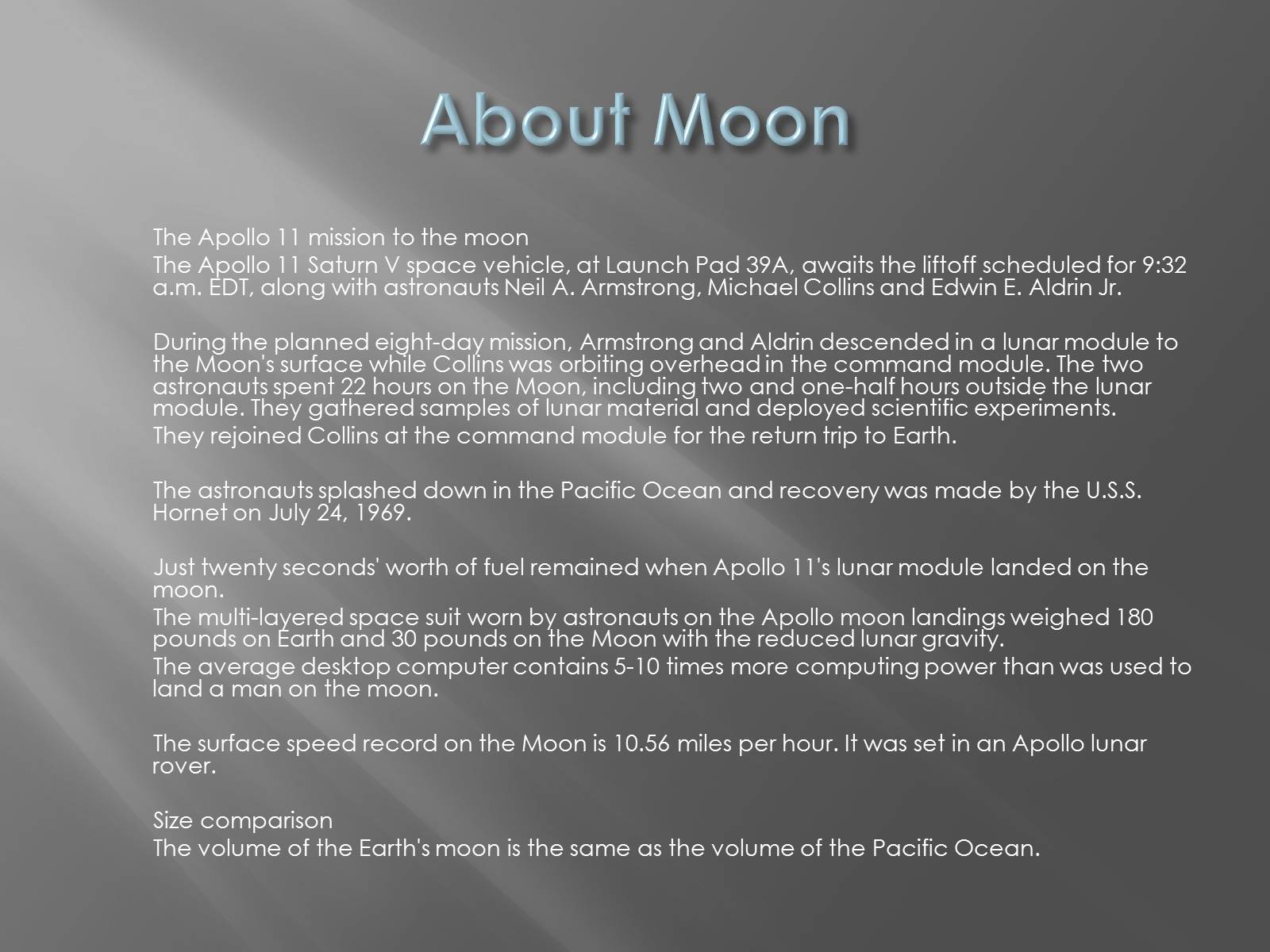
Слайд #6
About Moon
Lunar magnetic field
The Moon has no global magnetic field. You cannot use a compass to find your direction.
Strange Mathematics: 1/2 equals 1/4
A quarter moon and a half moon are the same thing. The quarter refers to the fraction of the lunar month which has passed, whilst the half describes the portion of the Moon's disc which is visible.
Calculation of the Easter date
Easter is the first Sunday after the first Saturday after the first full moon after the equinox. (The equinox is quite often March 21, but can also occur on the March 20 or 22.)
Tides and the moon
The moon causes many of the tides in the Earth's oceans. This is because of the gravity force between the Earth and Moon. At full Moon and new Moon, the Sun, Earth and Moon are lined up, producing the higher than normal tides (called spring tides, for the way they spring up). When the Moon is at first or last quarter, smaller neap tides form.
Sun and Moon Eclipses
An eclipse of the Sun can occur only at New Moon, while an eclipse of the Moon can occur only at Full Moon.
Moon Ingredients
The moon is not made of cheese.
Legal status - Buying land on the moon
Though several flags of the United States have been symbolically planted on the moon, the U.S. government makes no claim to any part of the Moon's surface. The U.S. is party to the Outer Space Treaty, which places the Moon under the same jurisdiction as international waters. This treaty also restricts use of the Moon to peaceful purposes, explicitly banning weapons of mass destruction (including nuclear weapons) and military installations of any kind. A second treaty, the Moon Treaty, was proposed to restrict the exploitation of the Moon's resources by any single nation, but it has not been signed by any of the space-faring nations.
Several individuals have made claims to the Moon in whole or in part, though none of these claims are generally considered credible
Lunar magnetic field
The Moon has no global magnetic field. You cannot use a compass to find your direction.
Strange Mathematics: 1/2 equals 1/4
A quarter moon and a half moon are the same thing. The quarter refers to the fraction of the lunar month which has passed, whilst the half describes the portion of the Moon's disc which is visible.
Calculation of the Easter date
Easter is the first Sunday after the first Saturday after the first full moon after the equinox. (The equinox is quite often March 21, but can also occur on the March 20 or 22.)
Tides and the moon
The moon causes many of the tides in the Earth's oceans. This is because of the gravity force between the Earth and Moon. At full Moon and new Moon, the Sun, Earth and Moon are lined up, producing the higher than normal tides (called spring tides, for the way they spring up). When the Moon is at first or last quarter, smaller neap tides form.
Sun and Moon Eclipses
An eclipse of the Sun can occur only at New Moon, while an eclipse of the Moon can occur only at Full Moon.
Moon Ingredients
The moon is not made of cheese.
Legal status - Buying land on the moon
Though several flags of the United States have been symbolically planted on the moon, the U.S. government makes no claim to any part of the Moon's surface. The U.S. is party to the Outer Space Treaty, which places the Moon under the same jurisdiction as international waters. This treaty also restricts use of the Moon to peaceful purposes, explicitly banning weapons of mass destruction (including nuclear weapons) and military installations of any kind. A second treaty, the Moon Treaty, was proposed to restrict the exploitation of the Moon's resources by any single nation, but it has not been signed by any of the space-faring nations.
Several individuals have made claims to the Moon in whole or in part, though none of these claims are generally considered credible
